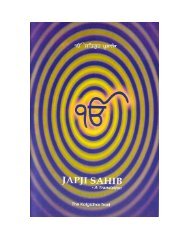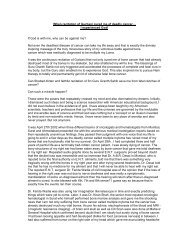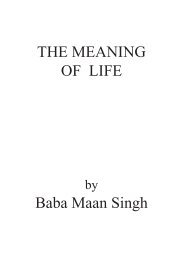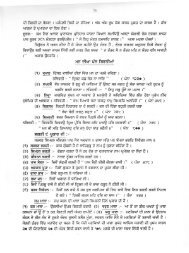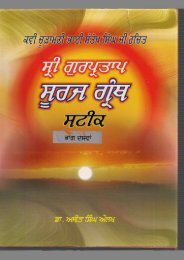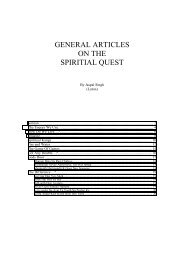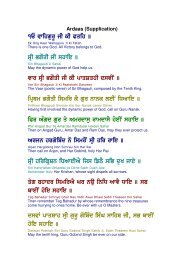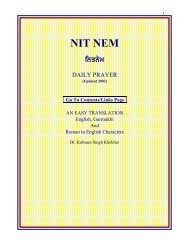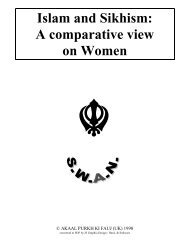Sant Jarnail Singh Bhindranwale - Sikh Missionary Society (UK)
Sant Jarnail Singh Bhindranwale - Sikh Missionary Society (UK)
Sant Jarnail Singh Bhindranwale - Sikh Missionary Society (UK)
Create successful ePaper yourself
Turn your PDF publications into a flip-book with our unique Google optimized e-Paper software.
<strong>Sant</strong> <strong>Bhindranwale</strong> had a charismatic personality and spoke in simple village idiom.Those who listened to him, were impressed by his simple living, personal charm, and clearthinking. Joyce Pettigrew, who met him in 1980, writes 91 : 'There was a very close associationbetween the <strong>Sant</strong> and the people, as I myself witnessed on a visit to meet <strong>Sant</strong> <strong>Bhindranwale</strong> inGuru Nanak Niwas.' According to Shiva, 92 <strong>Sant</strong> <strong>Jarnail</strong> <strong>Singh</strong> <strong>Bhindranwale</strong> 'gained hispopularity with the Punjab peasantry by launching an ideological crusade against the culturalcorruption of Punjab. The most ardent followers of <strong>Bhindranwale</strong> in his first phase of risingpopularity were children and women, both because they were relatively free of the new cultureof degenerative consumption, and they were worst hit by the violence it generated. In the secondphase of <strong>Bhindranwale</strong>'s popularity, men also joined his following, replacing vulgar movies withvisits to gurdwaras, and reading the 'gurbani' in place of pornographic literature. The <strong>Sant</strong>'sfollowing grew as he successfully regenerated the 'good' life of purity, dedication and hard workby reviving these fundamental values of the <strong>Sikh</strong> religion's way of life. The popularity of<strong>Bhindranwale</strong> in the countryside was based on this positive sense of fundamentalism asrevitalizing the basic moral values of life that had been the first casualty of commercialcapitalism. During the entire early phase of <strong>Bhindranwale</strong>'s preaching, he made no antigovernmentor anti-Hindu statement, but focused on the positive values of the <strong>Sikh</strong> religion. Hisrole was largely that of a social and religious reformer.'According to Khushwant <strong>Singh</strong> 93 :'Within a short period of becoming head of the Taksaal, <strong>Jarnail</strong> <strong>Singh</strong> came to berecognized as the most effective instrument of renaissance of <strong>Sikh</strong> fundamentalism. Hetoured villages exhorting <strong>Sikh</strong> youth to return to the spartan ways of the Khalsa startedby Guru Gobind <strong>Singh</strong>: not to clip their beards, to abstain from smoking, drinking andtaking drugs. Wherever he went, he baptized 94 young men and women by the hundreds.An integral part of his preaching was that all <strong>Sikh</strong>s should, as had been required by theirwarrior Guru Gobind <strong>Singh</strong>, be shastradharis - weapon-bearers.'Tully and Jacob 95 state that: 'In spite of the Government's propaganda, to many people<strong>Bhindranwale</strong> remained a sant, or holy man, not a terrorist.'The religious revival lead by <strong>Sant</strong> <strong>Bhindranwale</strong> resulted in a large number of <strong>Sikh</strong>s,especially the youth, receiving initiation into the <strong>Sikh</strong> faith. According to Khushwant <strong>Singh</strong> 96 :'<strong>Bhindranwale</strong>'s amrit prachar was a resounding success. Adults in their thousandstook oaths in public to abjure liquor, tobacco and drugs and were baptized. Video91 Joyce Pettigrew, The <strong>Sikh</strong>s of the Punjab: Unheard Voices of State and Guerrilla Violence, Zed Books Ltd., London, U.K.1995, page 35.92 Vandana Shiva, The Violence of The Green Revolution, Research Foundation for Science and Ecology, Dehra Dun, 1989,pages 129-130.93 Kuldip Nayar and Khushwant <strong>Singh</strong>, Tragedy of Punjab, Vision Books, New Delhi, 1984, page 25.94 Many writers erroneously use this term to describe the ceremony of taking Khande da Pahul or taking Amrit- formal initiationinto the <strong>Sikh</strong> faith.95 Mark Tully and Satish Jacob, Amritsar, Mrs. Gandhi's Last Battle, Rupa, New Delhi, 1985, pages 205-206.96 Khushwant <strong>Singh</strong>, A History of the <strong>Sikh</strong>s, Volume 2: 1839-1988, Second Edition, Oxford University Press, Delhi, India,1991, page 329.19




